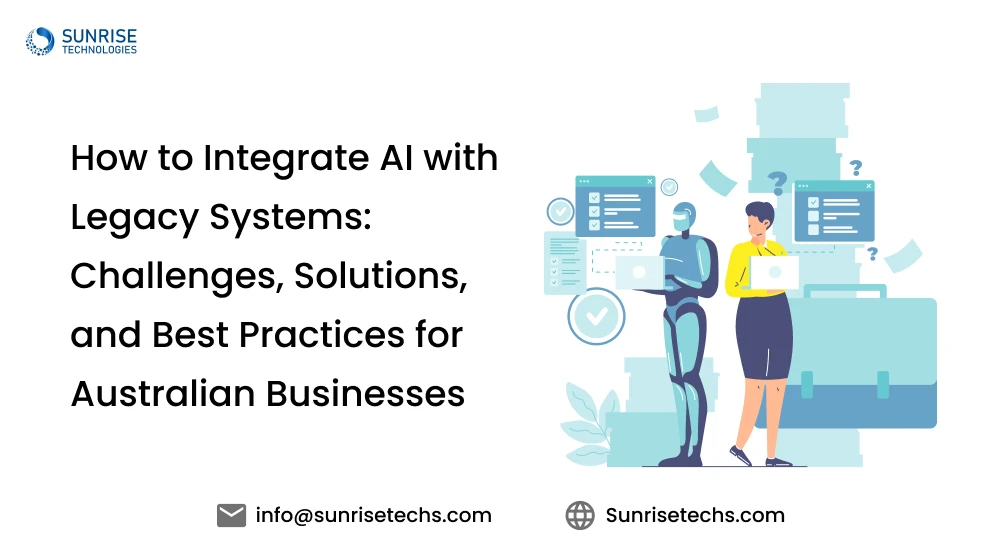
How to Integrate AI with Legacy Systems: Challenges, Solutions, and Best Practices for Australian Businesses
Oct 7, 2025
Technology is evolving at a faster pace than most businesses can keep up with. While new digital-first companies thrive on modern cloud-native platforms, many established Australian businesses still rely on legacy systems—the older but mission-critical software and infrastructure that run their daily operations. These systems are often reliable, but they are also rigid, limited in scalability, and costly to maintain.
So, the question most business leaders ask today is: “How do we integrate AI into our legacy systems without breaking what already works?”. As an AI development company in Australia, Sunrise Technologies has worked with organisations across finance, healthcare, logistics, and retail to integrate AI into legacy systems in a way that enhances operations without disrupting daily workflows. In this guide, we’ll cover the challenges, benefits, best practices, and expert insights you need to know.
Why Businesses Are Integrating AI Into Legacy Systems?
Modern AI capabilities—like predictive analytics, natural language processing, workflow automation, and AI-powered dashboards—are no longer just optional. They’re becoming essential for competitiveness. Here are the top benefits of AI integration for businesses:
- Extending the life of legacy systems: Instead of replacing entire infrastructure, businesses can upgrade legacy systems with AI to add intelligence, automation, and analytics.
- Smarter decision-making: AI-powered analytics can uncover insights from years of historical data locked inside legacy databases.
- Automation and cost savings: AI workflow automation solutions reduce repetitive manual tasks, freeing up employees for higher-value work.
- Improved customer experience: AI chatbots, recommendation engines, and predictive services integrate seamlessly with older CRM and ERP platforms.
- Supporting digital transformation: AI modernization services act as the bridge between legacy systems and digital-first strategies, helping companies adapt to the Australian market’s competitive pressures.
In short, AI development services allow companies to modernize without the risk and expense of full-scale system replacement.
Every legacy system is different. Our experts can map your current setup and provide a transparent cost breakdown for integrating AI without disrupting your business.
Challenges of AI and Legacy System Modernisation
While the benefits are clear, integration is never plug-and-play. As an AI consulting services provider in Australia, we often encounter the following challenges:
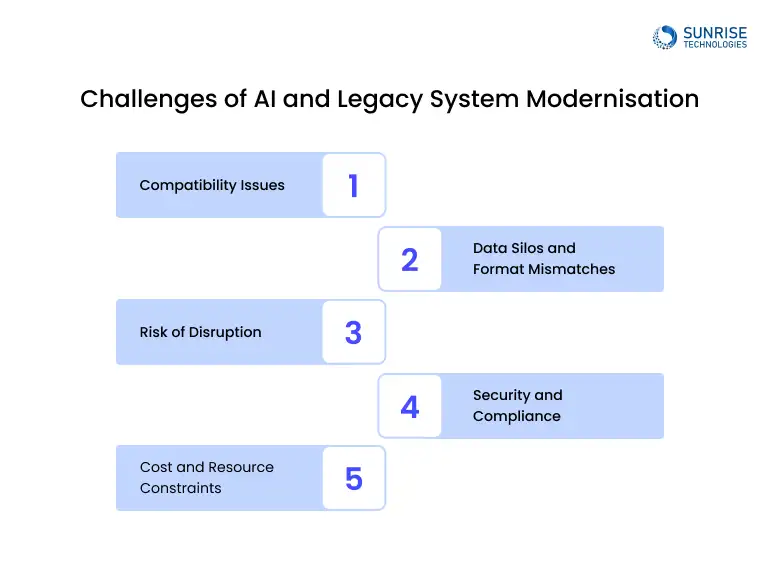
1. Compatibility Issues
Legacy systems weren’t built with AI in mind. Outdated architectures, closed ecosystems, and lack of API support can make integration difficult.
2. Data Silos and Format Mismatches
Most legacy databases store data in outdated or proprietary formats. AI models require clean, structured, and accessible data—which means businesses must plan for data migration, cleansing, and transformation.
One of our clients asked: “How do AI integrations handle data format mismatches with legacy databases?”
AI integration typically involves building data pipelines that transform legacy data into AI-ready formats. At Sunrise Technologies, we use ETL (Extract, Transform, Load) processes, middleware, and custom connectors to ensure smooth compatibility. This avoids data loss and ensures models can deliver accurate predictions.
3. Risk of Disruption
Many business leaders worry: “Will integrating AI into legacy systems disrupt daily operations?”. The truth: If done correctly, it won’t. AI integration can be staged in parallel environments, tested in sandboxes, and rolled out gradually. As an AI system integration company, we design integration roadmaps that ensure zero downtime.
4. Security and Compliance
With sensitive customer or financial data at stake, AI integration services must prioritise encryption, access controls, and compliance with Australian data regulations.
5. Cost and Resource Constraints
Businesses often assume integration requires huge budgets. In reality, custom AI solutions providers can design modular deployments—starting small (for example, adding an AI-powered analytics dashboard) and scaling as ROI becomes clear.
How AI Integrates with Legacy Systems?
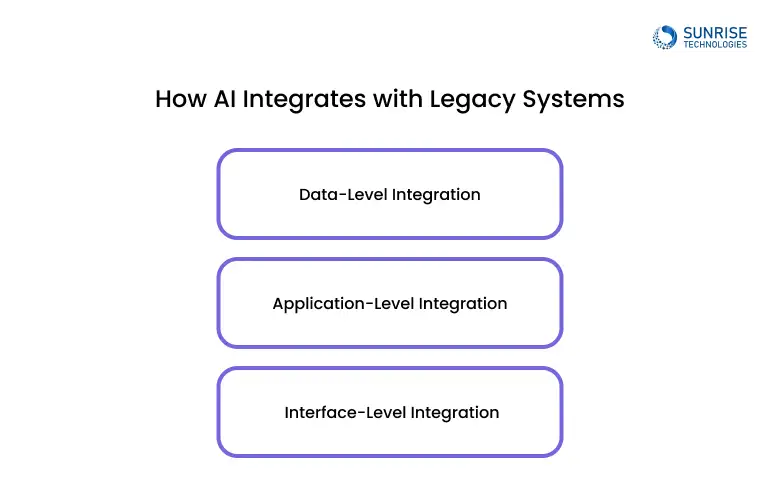
Integrating AI into legacy systems is not about tearing down what already exists—it’s about enhancing it. Legacy platforms, whether ERP, CRM, or industry-specific applications, often hold years (sometimes decades) of valuable business data. The problem is, these systems were built in an era when artificial intelligence wasn’t even on the radar. They are rigid, siloed, and limited in terms of analytics and automation.
That’s where AI integration services come in. Rather than replacing core infrastructure—which can be extremely costly and disruptive—businesses can upgrade legacy systems with AI by strategically layering modern capabilities on top of them. There are three primary ways this integration happens:
1. Data-Level Integration
This approach focuses on connecting legacy databases to AI engines. Most AI applications thrive on large volumes of clean, structured data. But legacy systems often store information in outdated formats or across silos that aren’t AI-ready.
Through ETL pipelines (Extract, Transform, Load), data lakes, and AI-enabled middleware, businesses can create a continuous data flow where legacy data feeds AI models. This enables:
- Predictive analytics for sales, demand, or customer behaviour
- Fraud detection using historical transaction patterns
- Smarter supply chain forecasting
Example: A logistics company in Australia connected decades of freight data stored in a legacy mainframe into an AI model that predicts delivery delays and optimises routes.
2. Application-Level Integration
Here, AI applications are embedded into existing workflows without altering the legacy software itself. This is where AI app development shines—think of it as plugging in a new tool that enhances the performance of your old system.
- AI chatbots integrated into legacy CRMs to improve customer support
- AI-powered recommendation engines running alongside eCommerce platforms
- AI workflow automation solutions that remove repetitive manual tasks from ERP processes
These applications sit on top of the existing system, ensuring minimal disruption while delivering visible value.
3. Interface-Level Integration
This is the most common and practical approach: using APIs, connectors, or middleware to make legacy and AI platforms communicate. APIs act as translators, ensuring AI-powered services—like predictive dashboards or natural language interfaces—can interact with older software. When APIs aren’t available, custom API wrappers can be developed by an AI system integration company, ensuring even the oldest platforms can leverage modern AI.
Example: A manufacturing firm’s 20-year-old ERP might not support advanced analytics. By adding an AI-powered analytics dashboard connected via APIs, the business gains predictive insights into inventory and production cycles—without modifying the ERP itself.
Not sure where to start? In this one-on-one session, our AI consultants in Australia will walk you through practical steps to integrate AI into your business—no jargon, just actionable advice.
What Role Do APIs Play in Connecting AI Solutions with Older Platforms?
When businesses think about integrating AI into legacy systems, the biggest hurdle is often compatibility. Legacy applications were not designed to “talk” to modern technologies. This is where APIs (Application Programming Interfaces) play a critical role.
Think of APIs as translators: they enable communication between the old system and the new AI-driven service without altering the legacy platform’s source code. For example, if your ERP or CRM was built 15 years ago, it may not support advanced data sharing. An API layer allows AI applications—like a machine learning model for demand forecasting or a natural language processing chatbot—to access and use that system’s data securely.
From an enterprise AI development services perspective, APIs bring three major benefits:
- Seamless connectivity: APIs enable AI tools to pull structured and unstructured data from legacy systems in real time.
- Scalability: Once an API layer is built, it can be reused for other AI applications, lowering the cost of future integrations.
- Reduced risk: APIs sit on top of the legacy system, avoiding disruptions to core functionalities and minimizing downtime.
But what if a legacy system doesn’t support APIs? In such cases, custom API wrappers or middleware can be developed. As an AI system integration company, we often design middleware that acts as a bridge—converting legacy data formats into AI-ready inputs. This ensures even decades-old software can leverage AI integration services without requiring replacement. In short: APIs are the cornerstone of AI modernization services. They give businesses the flexibility to innovate while protecting investments already made in older infrastructure.
How to Integrate AI-Powered Analytics Dashboards with a Legacy ERP?
Legacy ERP systems manage inventory, finances, HR, and operations, but reporting is often their weakest point. Traditional ERP reports are static, limited, and require manual exports. AI-powered analytics dashboards address these limitations. An AI-enabled dashboard doesn’t just show data—it interprets it. It can highlight anomalies, predict trends, and provide decision-makers with actionable insights in real time. The integration process typically looks like this:
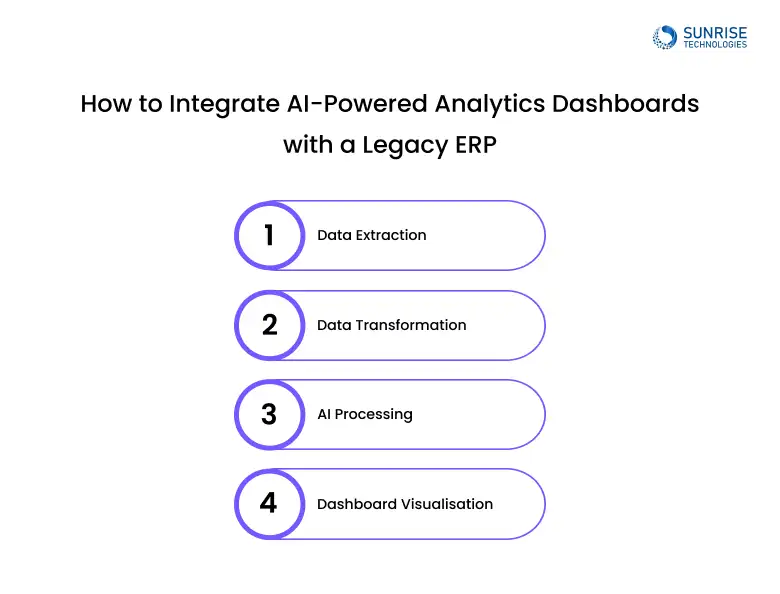
- Data Extraction: Using APIs, connectors, or database queries, data is pulled from the legacy ERP.
- Data Transformation: The extracted data is cleaned, normalized, and structured so AI models can process it effectively. This addresses data format mismatches.
- AI Processing: Machine learning models detect patterns, forecast demand, optimise supply chains, or track financial KPIs.
- Dashboard Visualisation: Insights are displayed in modern, interactive dashboards accessible to managers and executives.
Here’s the real power: instead of just showing “what happened”, AI dashboards answer “why it happened” and “what’s likely to happen next”. For example, a retailer can get a predictive dashboard showing future demand trends, risk alerts, and customer behaviour patterns. This type of AI modernization service is particularly attractive to Australian businesses because it delivers immediate ROI. Without overhauling the ERP, companies gain advanced analytics that improve decision-making and competitiveness. At Sunrise Technologies, our AI development services often start with analytics dashboards because they are low-disruption, quick-to-implement, and deliver visible results that build trust in the wider integration journey.
We don’t just deliver AI integration—we ensure it runs smoothly. Get 8 weeks of free monitoring, support, and optimizations with your AI development project.
Best Practices for Successful AI Integration
From our experience as an AI development company, here are best practices that make AI adoption seamless:
- Assess system readiness: Audit your legacy systems for compatibility, data quality, and integration points.
- Start with pilot projects: Begin with AI workflow automation solutions or AI-driven reporting before expanding.
- Leverage APIs and middleware: Ensure smooth communication between AI apps and older platforms.
- Focus on data quality first: AI is only as good as the data it trains on. Invest in cleansing, normalising, and unifying legacy data.
- Involve stakeholders early: IT teams, business leaders, and end-users should be aligned from day one.
- Work with experts: A trusted AI development company in Australia ensures compliance, scalability, and reliability throughout the project.
Will Integrating AI into Legacy Systems Disrupt Daily Operations?
This is a common concern: “If I integrate AI into my existing systems, will it break what I rely on every day?”
The short answer is no — if done correctly. AI integration enhances, not replaces, your legacy systems. At Sunrise Technologies, we ensure smooth adoption through:
- Parallel Deployment: AI is deployed in a test environment or “sandbox,” running alongside the legacy system without interference to measure accuracy and reliability.
- Phased Rollouts: AI components are introduced gradually—starting with non-critical workflows (like reporting automation) and later expanding to mission-critical areas.
- Fallback Mechanisms: If an AI service underperforms, the legacy system continues to function, guaranteeing continuity.
- Training and Support: Users are guided through changes so AI-enabled workflows integrate smoothly without disruption.
For Australian businesses, this staged and controlled approach is crucial. Whether you’re running an ERP in manufacturing or a core banking platform, enterprise AI development services ensure that day-to-day operations continue smoothly while AI adds value in the background.
How Do AI Integrations Handle Data Format Mismatches with Legacy Databases?
Data is the foundation of AI, but legacy systems often store it in outdated or proprietary formats that modern AI engines can’t use directly. Here’s how integration challenges are solved:
- ETL (Extract, Transform, Load) Pipelines: Data is extracted from legacy databases, transformed into modern formats (JSON, CSV, API-ready), and loaded into AI models.
- Middleware & Connectors: Custom-built connectors act as translators between old database schemas and AI applications (e.g., converting COBOL-based records for machine learning).
- Data Lakes & Warehousing: Large volumes of legacy data are migrated into cloud-based data lakes, cleaned, normalised, and prepared for AI processing.
- Anonymisation & Compliance: Sensitive information is anonymised to meet Australian data privacy regulations.
Example: A healthcare provider in Australia may store patient records in an old SQL system. Before applying AI workflow automation for predictive diagnostics, data is standardised into HL7 or FHIR formats. This ensures the AI solution works accurately while maintaining compliance and data integrity.
Working with an experienced AI consulting services provider in Australia allows businesses to overcome data mismatches without losing historical value. This enables decades of legacy records to feed into AI solutions that deliver smarter insights.
From customer support bots to intelligent workflow automation, our custom AI solutions help businesses modernise legacy systems while boosting efficiency.
Choosing the Right AI Development Partner in Australia
Selecting the right partner for AI integration services is not just a technical decision—it’s a strategic one. Many Australian businesses operate on critical legacy systems, and the wrong approach can mean wasted budgets, downtime, or solutions that don’t scale. That’s why working with an experienced AI development company in Australia is essential.
The right partner should offer a full spectrum of AI development services, going beyond just model building. At Sunrise Technologies, we’ve seen the biggest impact come from solutions that directly address user pain points and operational needs.
Here are the most in-demand AI services businesses in Australia look for today:
1. AI Agents for Business Operations
AI agents are fast becoming a core requirement across industries:
- Customer Support Agents: AI chatbots or voice agents integrated with legacy CRMs to provide 24/7 support.
- Personal Productivity Agents: AI assistants that help employees schedule, draft reports, or pull data from legacy systems.
- Marketing & Sales Agents: AI-driven recommendation engines and lead-nurturing bots that boost revenue without overhauling the CRM.
- Operations Agents: Intelligent agents that monitor workflows, raise alerts, and trigger automated tasks in ERP systems.
2. AI Workflow Automation Solutions
Manual, repetitive tasks are one of the biggest inefficiencies in legacy systems. AI workflow automation eliminates these bottlenecks by:
- Automating invoice processing, approvals, and compliance checks
- Streamlining HR onboarding, payroll, and leave management
- Handling supply chain updates like inventory forecasting and restocking
- Enabling “hands-free” back-office operations through AI scripts and bots
This is often the first step businesses take, because the ROI is immediate and employee productivity jumps quickly.
3. AI-Powered Analytics & Dashboards
As discussed earlier, legacy systems struggle with meaningful reporting. AI dashboards add:
- Predictive insights (what’s likely to happen next)
- Root-cause analysis (why something happened)
- Real-time monitoring across sales, finance, and operations
For executives, this is one of the most valuable AI app modernization services, because it converts historical data into future-proof decision-making tools.
4. Custom AI Solutions for Industry-Specific Needs
Every business is different, and custom AI solutions providers tailor tools to fit specific models:
- Retail & eCommerce: AI product recommendation engines and dynamic pricing models
- Healthcare: AI diagnostic tools and patient workflow management
- Finance: Fraud detection, risk scoring, and compliance automation
- Logistics & Manufacturing: Predictive maintenance and AI-driven supply chain optimisation
5. AI App Development
Sometimes, the best way to extend a legacy system’s value is to build a companion app powered by AI:
- A mobile app connecting to your ERP for AI-powered sales forecasts
- An employee-facing app using natural language processing to pull reports from legacy systems on demand
- A customer-facing app integrating with legacy CRMs for personalised engagement
This modernises without replacement, giving businesses agility while protecting existing investments.
Final Thoughts
Integrating AI into legacy systems isn’t about chasing trends—it’s about preparing your business to stay relevant for the next decade. The smartest companies start small, solve one meaningful problem, and expand step by step. Think of AI as an evolutionary upgrade, not a complete overhaul. Focus on areas where AI can deliver immediate, visible value—automating workflows, providing intelligent assistants, or unlocking insights buried in years of data.
Think of AI as an evolutionary upgrade, not a complete overhaul. Focus on areas where AI can deliver immediate, visible value—automating workflows, providing intelligent assistants, or unlocking insights buried in years of data.
Technology is only half the equation. The other half is alignment—choosing a partner and approach that understand your existing systems, people, and market. When AI works hand-in-hand with what you already have, transformation feels seamless rather than disruptive.
In short—don’t look for AI to replace legacy systems overnight. Look for it to amplify them. Start where it matters most, build momentum, and let results guide your next move. Done right, AI won’t just extend the life of your systems—it will extend your business vision.
Yes. Even if a vendor has discontinued support, AI system integration companies often build middleware or API layers that allow AI models to interact with outdated software. The critical factor is ensuring security patches and monitoring are in place to reduce risks.
Security depends on how data pipelines are architected. Best practice is to use encrypted API calls, tokenized authentication, and role-based access control. In Australia, compliance with privacy laws (such as the Privacy Act 1988) is essential when AI touches sensitive data.
Poorly integrated AI can increase system strain, but a well-designed AI modernization service actually reduces bottlenecks. For instance, moving heavy AI computations off-premise or into cloud microservices ensures the legacy system isn’t overloaded.
Absolutely. Businesses can choose on-premise AI deployment or hybrid setups where sensitive data never leaves internal servers. AI consulting services in Australia often recommend differential privacy or anonymisation techniques for high-risk sectors.
Compliance is a key consideration. AI integrations must be auditable, explainable, and aligned with industry-specific regulations (HIPAA for healthcare, APRA for finance, etc.). Many Australian enterprises choose custom AI solutions that include compliance-focused workflows.
Yes. A sandbox or digital twin of the legacy system can be created. This allows AI models to be trained, tested, and stress-checked before being pushed live—minimising operational risk.
AI workflow automation often introduces event-driven triggers or batch processing. For example, an AI agent can monitor legacy logs and trigger tasks asynchronously, providing automation without forcing the system into real-time mode.
It varies by industry, but AI can typically extend the usability of a legacy system by 5–7 years, especially if paired with continuous upgrades like predictive maintenance, smarter analytics, and automated workflows.
When done correctly, AI integration should decouple rather than lock you in. Using APIs, microservices, and modular AI apps ensures that when you eventually migrate, much of your AI layer can be reused.
Beyond development, hidden costs often include:
- Data cleaning and transformation
- Staff training on new AI tools
- Ongoing monitoring and retraining of AI models
- Upgrades to networking and storage infrastructure
Sam is a chartered professional engineer with over 15 years of extensive experience in the software technology space. Over the years, Sam has held the position of Chief Technology Consultant for tech companies both in Australia and abroad before establishing his own software consulting firm in Sydney, Australia. In his current role, he manages a large team of developers and engineers across Australia and internationally, dedicated to delivering the best in software technology.



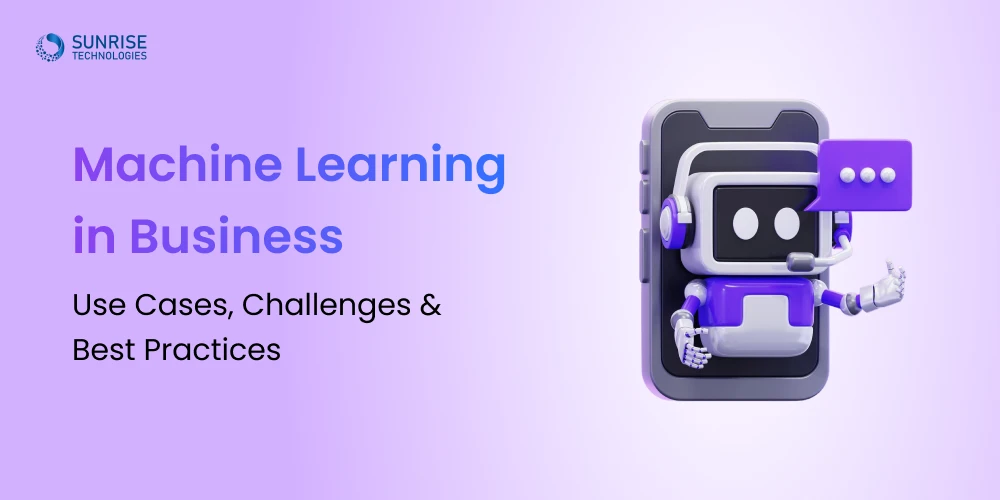
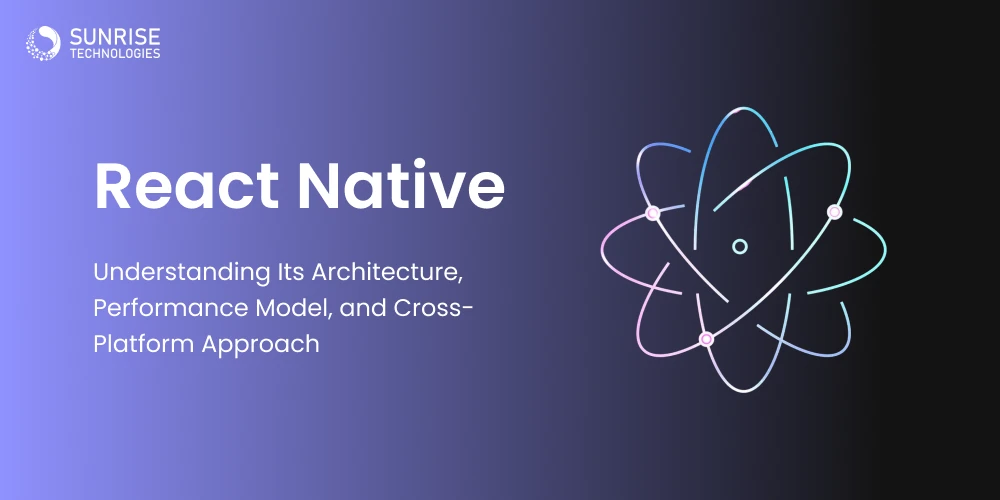
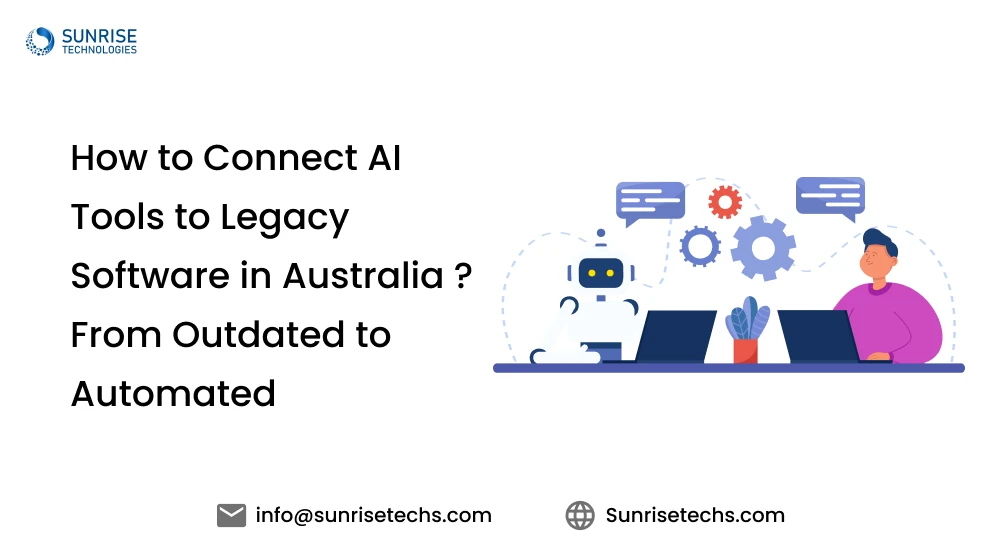
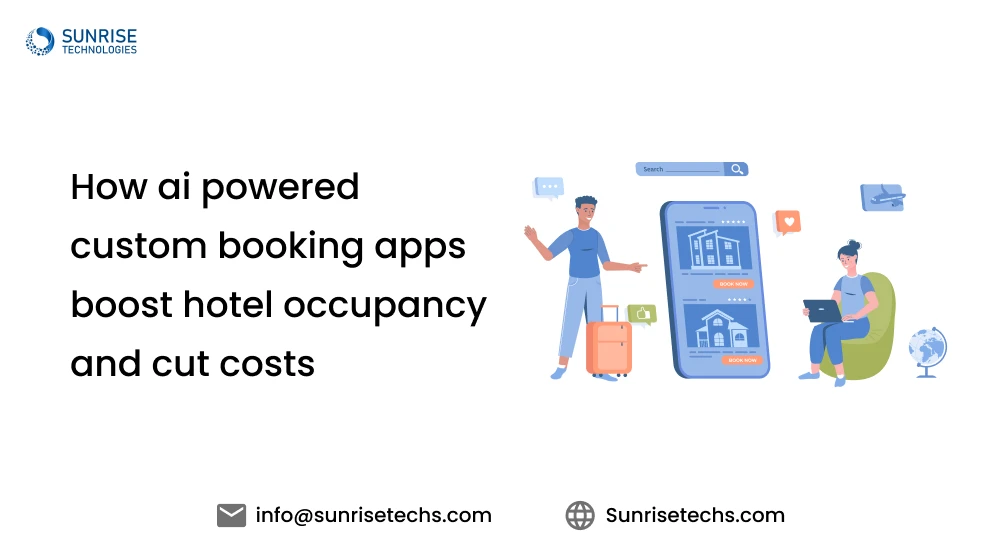


Cloud Based Project Management Platform
Read the challenges we faced and how we helped
View Case Study











